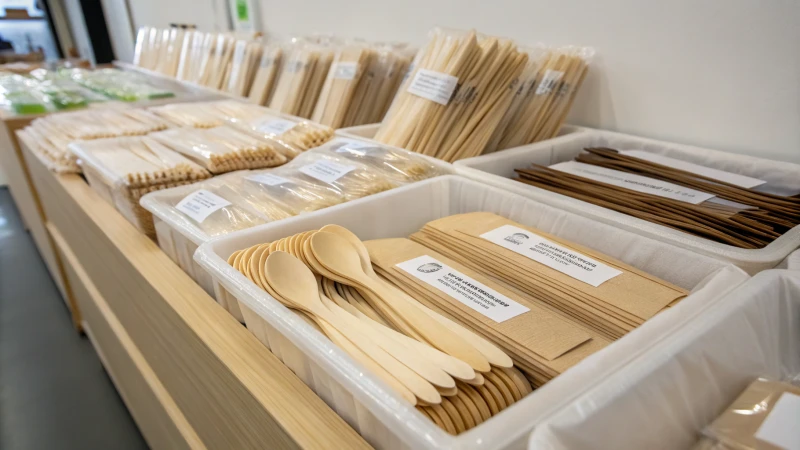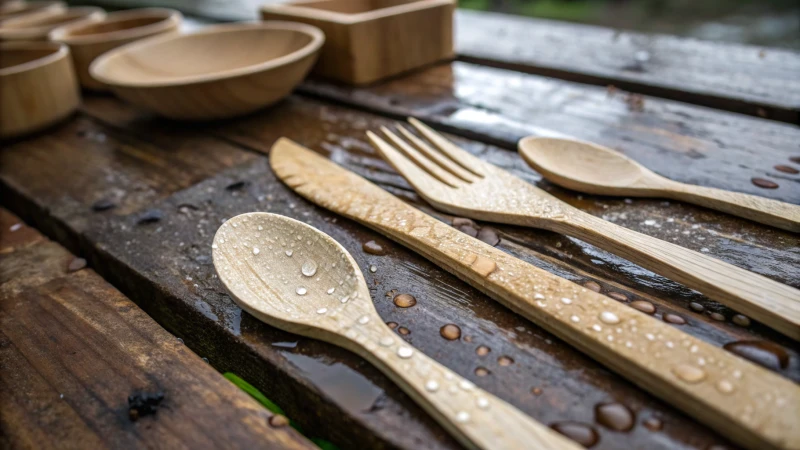
Ever wondered how a simple thing like cutlery can be affected by its journey?
Transportation and storage conditions can significantly impact the quality of disposable wooden cutlery. By maintaining ideal temperature, humidity, and using proper packaging, businesses can preserve the integrity and appeal of their products, ensuring they remain durable and eco-friendly.
When I first started exploring eco-friendly dining options, I never imagined that something as routine as transporting wooden cutlery could present such challenges. But as it turns out, the journey from the factory to your dining table is fraught with potential pitfalls. In the sections that follow, I’ll share insights and tips on optimizing these conditions—lessons I learned the hard way—so you can keep your wooden cutlery at its best.
Humidity affects the durability of wooden cutlery.True
High humidity can cause wooden cutlery to warp or degrade.
Temperature has no impact on wooden cutlery quality.False
Extreme temperatures can affect the integrity of wooden cutlery.
What environmental factors impact wooden cutlery during transport?
When I first started exploring sustainable alternatives, I was amazed by the challenges wooden cutlery faces on its journey from the factory to your table.
Temperature, humidity, and packaging are key factors that affect wooden cutlery during transport. Proper temperature control prevents warping, managing humidity levels avoids mold growth, and effective packaging protects against physical damage and contamination.

Temperature Fluctuations: A Key Concern
I remember the first time I learned about the effects of temperature on wooden cutlery. It was a scorching summer day, and I noticed how heat could cause the wood to warp or dry out, making it unusable. On the flip side, during a chilly winter shipment, I realized how cold could lead to cracking. That's when I understood the importance of using temperature-controlled storage. Investing in temperature monitoring systems1 can be a game-changer, ensuring that the cutlery stays pristine throughout its journey.
The Impact of Humidity Levels
Humidity is another tricky factor. Once, while unpacking a shipment, I discovered some pieces had developed mold due to high moisture levels. That was a wake-up call. Since then, I always make sure to include humidity-regulating materials like silica gel packs in our packaging. These not only keep the wood from swelling but also help maintain an ideal moisture balance. Packaging solutions that seal against external humidity yet allow some air circulation have become a staple in my strategy.
Packaging Methods: The Unsung Hero
I can't stress enough how crucial good packaging is. One time, a package arrived with its contents jostled around so much that many pieces were damaged. That's when I switched to more robust packaging options. Now, whether it's biodegradable wraps or foam inserts for shock absorption, each choice aligns with our eco-friendly goals.
A table below illustrates effective packaging practices:
| Packaging Type | Benefits |
|---|---|
| Biodegradable wraps | Eco-friendly, customizable |
| Foam inserts | Shock absorption during transit |
| Sealed plastic bags | Barrier against moisture and dirt |
By employing sustainable packaging solutions2, not only do I protect the cutlery, but I also enhance our brand image by showcasing our commitment to eco-consciousness.
Ensuring Quality Stability Across Markets
Every region has its own set of environmental challenges. For example, when shipping to tropical areas, managing humidity becomes even more critical, whereas colder regions require more focus on preventing cracks due to the chill. This understanding has taught me the value of partnering with local logistics experts. Their insights into market-specific requirements have been invaluable.
Incorporating local market analysis3 into our strategies ensures that the quality of our wooden cutlery remains consistent no matter where it's headed.
Temperature fluctuations can warp wooden cutlery.True
Extreme heat and cold conditions affect the shape and integrity of wood.
Silica gel packs increase humidity in packaging.False
Silica gel packs absorb moisture, reducing humidity inside packaging.
How Does Humidity Affect Wooden Cutlery Quality?
Ever notice how your wooden spoons seem a bit wonky after a rainy week? Humidity plays a sneaky role in shaping the quality of wooden cutlery.
Humidity can make wooden cutlery expand, contract, and even warp or crack. By storing and packaging them properly, you can keep your cutlery in tip-top shape and looking fabulous.

The Science Behind Wood and Humidity
I remember the first time I noticed how humidity could wreak havoc on wooden cutlery. It was during a particularly muggy summer, and my favorite wooden spoon seemed to have developed a strange curve overnight. This got me curious. Turns out, wood is hygroscopic. This means it absorbs moisture from the air, expanding when it's humid and shrinking when it's dry. If you've ever experienced a sticky drawer or a creaky floorboard, you've felt this phenomenon firsthand.
| Humidity Level | Effect on Wooden Cutlery |
|---|---|
| High | Expansion, potential warping |
| Low | Contraction, cracking |
Practical Implications for Users
For users like Sarah4 and Emily5, understanding these effects is crucial. When high humidity hits, wooden cutlery might not only warp but also lose its smooth finish. This not only affects the user experience but can also diminish the aesthetic quality that brands like Emily's high-end restaurant chain pride themselves on.
Best Practices for Storage and Transportation
To keep your wooden cutlery looking and performing its best, consider proper storage6 as key. I once learned the hard way that leaving them in a damp kitchen drawer can be disastrous. Using desiccants or maintaining a climate-controlled environment during transportation can help. It's wise to store cutlery in areas with stable humidity levels to avoid those pesky expansions and contractions.
Understanding Market Needs
Professionals such as Michael7 in sustainable procurement should be on the lookout for suppliers who understand how to handle wood's sensitivity to humidity. I always advise checking if they offer guidance on storage conditions to ensure the cutlery maintains its quality from factory to fork.
Factors Influencing Humidity Effects
Besides humidity, temperature changes and packaging methods are significant too. I remember discussing with a supplier about using airtight packaging; it can prevent moisture exchange and preserve cutlery quality8 during transit. Choosing the right supplier who knows these nuances and implements necessary precautions can make all the difference in keeping your wooden cutlery pristine.
High humidity causes wooden cutlery to warp.True
Wood absorbs moisture in high humidity, leading to expansion and warping.
Low humidity prevents wooden cutlery from cracking.False
Low humidity causes wood to lose moisture, leading to contraction and cracking.
What Are the Best Packaging Methods for Wooden Cutlery?
Ever wondered how to keep wooden cutlery eco-friendly yet stunningly packaged?
The best packaging methods for wooden cutlery use sustainable materials like recycled cardboard, biodegradable wraps, and protective coatings to prevent moisture damage, ensuring the cutlery stays in perfect condition during storage and transit.

Understanding the Importance of Packaging
I still remember when I first started exploring sustainable alternatives for everyday products. Back then, it seemed like a puzzle I couldn't quite solve. But as I delved deeper, I realized that packaging isn't just about looks—it's about keeping the product safe from factors like temperature and humidity, which can be quite the culprits when it comes to wooden cutlery. Choosing eco-friendly packaging not only syncs with green values but also shields the product.
Material Choices
In my quest for sustainability, I discovered that not all packaging is created equal. Recycled cardboard and biodegradable wraps became my go-to choices. They do more than just reduce our carbon footprint; they provide the protection needed to keep everything intact. Adding a protective coating was like the cherry on top, offering extra defense against moisture.
| Material | Benefits |
|---|---|
| Recycled Cardboard | Eco-friendly, provides structural support |
| Biodegradable Wraps | Reduces plastic waste, compostable |
| Protective Coatings | Guards against humidity, maintains product quality |
Explore more about sustainable materials9 to understand their impact.
Innovative Design Approaches
I've always believed in the power of design to transform perception. Designing packaging that is both functional and visually appealing can do wonders for a brand's image. I learned that designs allowing for easy stacking and showcasing products with window cutouts can captivate eco-conscious buyers.
Discover design trends in packaging10 that appeal to modern consumers.
Ensuring Quality During Transportation
Transporting these eco-friendly treasures requires as much care as crafting them. Packaging needs to cushion and protect against inevitable bumps along the way. Using dividers or inserts can keep each piece snug and secure.
Adapting to Market Needs
I've noticed how different markets have distinct preferences. For instance, European clients often focus on recyclability, while cost-effectiveness might be a priority in Asian markets. Understanding these nuances helps me tailor my packaging strategies effectively.
Learn about market-specific packaging preferences11.
Biodegradable wraps reduce plastic waste in packaging.True
Biodegradable wraps are compostable, reducing reliance on plastic.
Protective coatings make cutlery heavier for transport.False
Protective coatings guard against humidity without adding significant weight.
How Can I Ensure Quality Stability Across Different Markets?
Ever tried juggling flaming torches while riding a unicycle? That's kind of what managing product quality across global markets feels like!
To ensure quality stability across different markets, I focus on standardizing processes, adapting to local regulations, investing in robust supply chain management, and utilizing technology for real-time monitoring and feedback.

Standardizing Processes Across Borders
Standardizing processes is like finding your favorite comfy sweater—it fits perfectly, no matter where you are. For me, this means creating universal operating procedures12 that align with our company's quality standards. Whether I'm sitting in a bustling New York office or a serene Tokyo café, I know these guidelines keep our product quality rock solid.
- Documentation: Create detailed manuals and training materials because clarity is key.
- Training Programs: Regularly train employees to understand and implement these standards, making them feel like part of the global team.
Adapting to Local Regulations
Navigating local regulations can feel like decoding an ancient map. Each market has its own set of rules, and it’s crucial to adapt operations accordingly. I've learned that modifying product designs or processes to comply with local laws isn't just necessary—it's a show of respect to the communities we serve.
- Regulatory Research: Conduct thorough research on local market regulations as the first step in crafting compliant strategies.
- Compliance Audits: Regular audits are my compass, ensuring we're on the right path and pinpointing areas for improvement.
Investing in Supply Chain Management
The supply chain is the backbone of quality consistency. It's like building a bridge between diverse markets. I focus on developing relationships with reliable suppliers and investing in logistics solutions that minimize disruptions—because, let’s face it, nobody wants their products stuck in transit purgatory!
- Supplier Vetting: Choose suppliers with a track record of high-quality outputs for peace of mind.
- Logistics Optimization: Use technology to optimize routes and reduce transportation times, keeping everything flowing smoothly.
Utilizing Technology for Monitoring
Technology is my trusty sidekick in maintaining quality consistency. Real-time monitoring systems are like having eyes everywhere, allowing me to spot issues quickly and take immediate action.
| Technology | Benefits |
|---|---|
| IoT Devices | Track product conditions in transit |
| ERP Systems | Streamline operations across locations |
| Data Analytics | Predict potential quality issues |
With these tools, I can delve into supply chain processes13 and make informed, data-driven decisions.
Feedback Mechanisms
Incorporating customer feedback is like receiving a direct hotline to the heartbeat of each market. It’s invaluable for understanding how products perform and where improvements are needed.
- Surveys: Conduct regular surveys to gather honest customer opinions.
- Feedback Loops: Implement systems that allow quick response to feedback keeps us agile and responsive.
By focusing on these strategies, I can maintain—and even enhance—our product quality across diverse markets. This not only caters to local needs but also bolsters our brand's global reputation.
To sustain success across borders, integrating these strategies into our operations is key. It aligns with local demands while upholding our global standards, ensuring a consistent brand image worldwide.
For more insights into supply chain management tools14 that can enhance your operations, check out additional resources online.
Stay tuned for more deep dives into mastering international market challenges and optimizing business strategies.
Standardized processes ensure consistent quality globally.True
Standardized processes help maintain uniform quality across all markets.
Ignoring local regulations can improve market efficiency.False
Ignoring local regulations can lead to legal issues and market inefficiencies.
Conclusion
Transportation and storage conditions, including temperature, humidity, and packaging, significantly affect the quality of disposable wooden cutlery. Proper management ensures durability and eco-friendliness throughout its journey.
-
Exploring this link provides insights into maintaining optimal temperatures during transit, crucial for preserving wooden cutlery quality. ↩
-
This link offers information on eco-friendly packaging methods that protect products while supporting sustainability initiatives. ↩
-
Discover how understanding local conditions can optimize transport strategies for maintaining product quality across regions. ↩
-
Learn how environmental conditions affect wooden utensils in culinary applications. ↩
-
Discover how eco-friendly products remain stable under different humidity levels. ↩
-
Find effective strategies for storing wooden products in variable climates. ↩
-
Explore suppliers who prioritize sustainable practices and quality maintenance. ↩
-
Understand methods to protect wood from humidity damage during shipping. ↩
-
Learn about various sustainable materials and their environmental benefits. ↩
-
Stay updated on the latest packaging designs that attract eco-conscious consumers. ↩
-
Discover how packaging needs differ across global markets. ↩
-
Understanding universal operating procedures can help create consistent quality standards across all markets. ↩
-
Optimizing supply chain processes ensures efficiency and consistency in quality delivery. ↩
-
Discover the latest tools that can streamline your supply chain for better quality control. ↩

